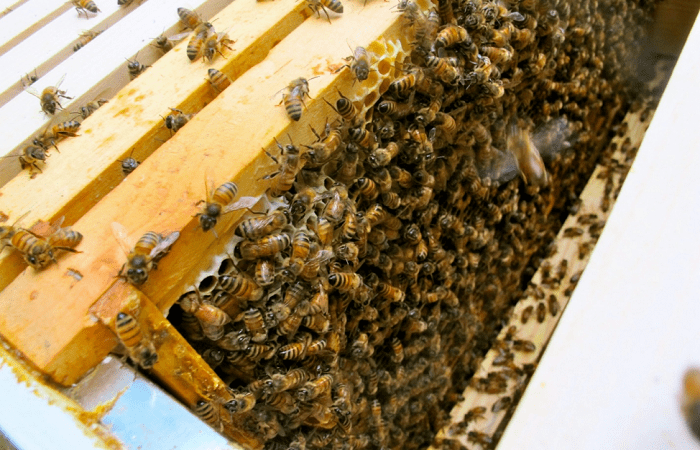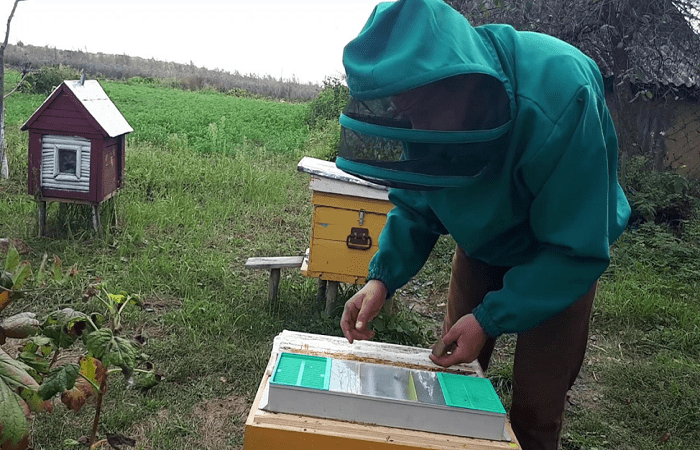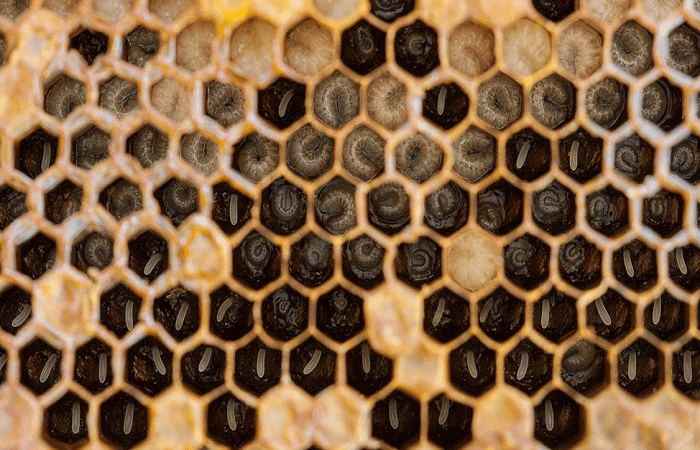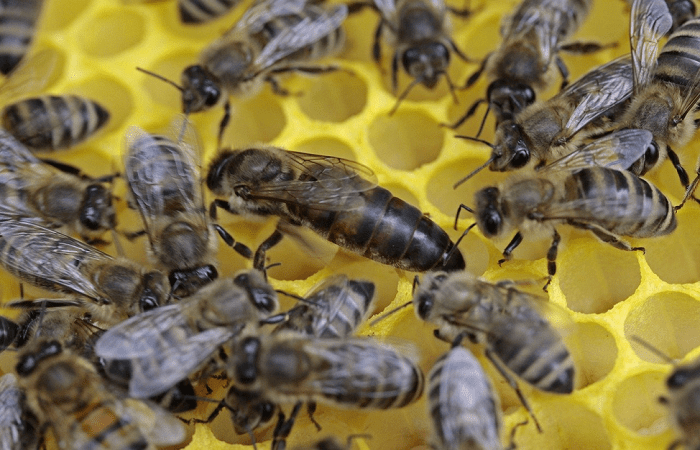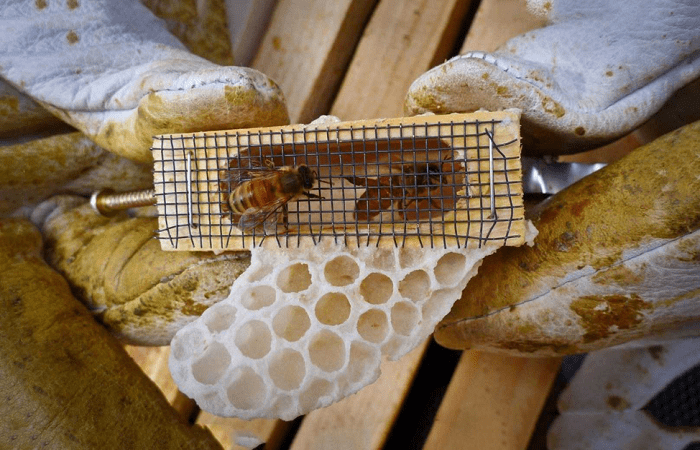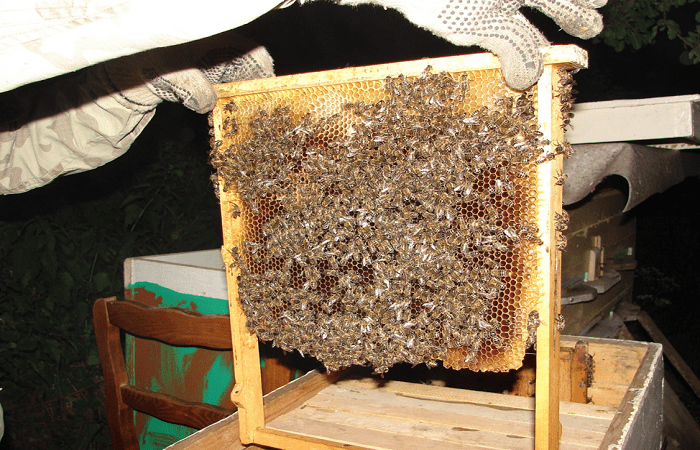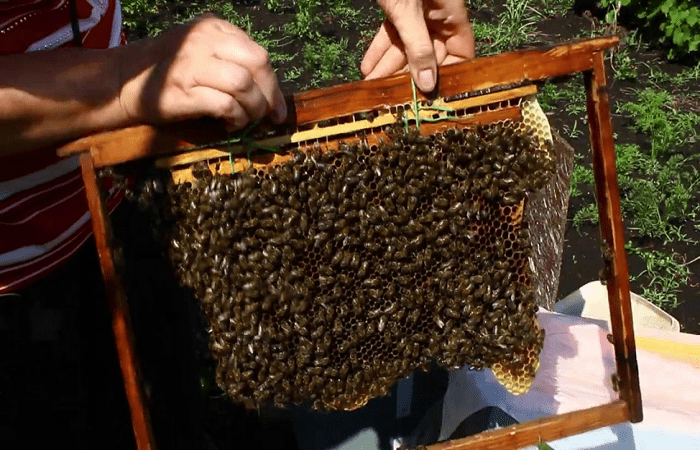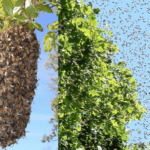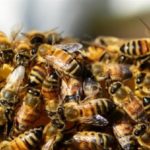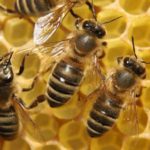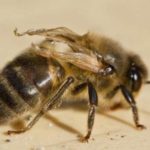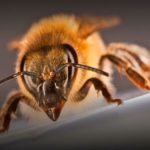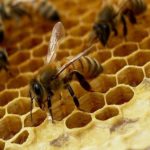Swarming is a common process for wild bees, through which colonies are separated and the insect population increases. In most cases, beekeepers do not need such reproduction (an uncontrolled increase in the number of individuals may begin in the apiary). In 12-frame hives, they try to use anti-swarm methods to prevent the formation of additional colonies.
- Biology of the process
- Division of families for half a summer
- Additional open brood
- Vitvitsky method
- Plaque on the uterus
- Dividing grid
- Breeding work
- Changing the uterus and two-uterus maintenance
- Demari method
- Dernov's technique
- Taranov method
- Cutting off swarm queen cells
- Formation of layering
- Prevention measures
Biology of the process
The separation of new families is a property inherent in the biological program of insects, occurs naturally and is considered a distinctive feature of a standard developing bee colony. Reasons why swarming begins:
- a significant increase in temperature in the hive - as soon as the level goes beyond +36 °C, the resettlement program is activated;
- with a sharp increase in the number of individuals (usually after reproduction in the spring-summer period), the “house” becomes crowded, which also becomes a signal for the formation of daughter bee colonies;
- the family does not have a usual bribe - this means that the bees are resting and “out of idleness” begin to look for new places where they can form bribes.
Attention! Bee species do not swarm the same way. Some species disperse spontaneously - up to 12 separated bee colonies (sometimes more) can form in a short period of time. For others - for example, crosses with the Georgian breed - this is an infrequent phenomenon with which the beekeeper has practically no trouble.
Division of families for half a summer
The method is that the current number of bees is divided into two approximately equal halves. The necessary conditions:
- flocks in the spring should be sufficiently stable and well-fed to easily endure resettlement (by the end of May, the nests should be filled);
- There should be several dense queens available.
Process - during the summer, an empty hive is brought to the strong half, where the frames have been moved in advance (it is important that bees, honey, beebread and brood are present inside). It’s good if you can track where the uterus is, but you don’t need to specifically look for it.
Attention! In order for the resettlement to proceed evenly and without problems, the new hive must copy the old one in shape, size and color.The houses are moved further away from each other, one can be left in the same place.
Additional open brood
This option is preferred by most beekeepers. Process Features:
- open brood is present in small quantities, and more royal jelly is produced than necessary;
- bees begin to consume unnecessary amounts of milk, and over time, overeating occurs;
- then oversaturated individuals begin to lay unfertilized eggs;
- at a certain point, these become the majority, and during honey collection they begin to swarm, which needs to be prevented.
Vitvitsky method
The basis of this technique, used in beekeeping to prevent swarming, is the division of an occupied nest. It is necessary to use an additional empty stake, with which you need to separate the nest. After this, an empty space will form, the bees will begin to occupy it, and there will be no time or energy left to divide into new families.
Plaque on the uterus
An additional option, which is carried out as follows:
- it is necessary to take a spare housing from the home;
- Attach a separate bottom (preferably made of plywood) from below;
- the frames with the queen are moved to a new place;
- the brood and queen cell are left in place;
- food and dry food are added to the remaining frames, and the structure is covered with canvas;
- The spare housing is installed on top.
Attention! This method is used when it was not possible to prevent the swarming of bees - the division of insects into families became noticeable (the beginning of the process), and new queen cells began to be laid.
Dividing grid
The name of the method indicates the method of work to combat possible swarming of bees in beds. The element is positioned to separate the growing brood from the queen. The upper part of the housing body is separated, and a grate is placed between the top and bottom. To prevent the queen from “escaping” into the lower body, she should be removed from the hive for a short time.
Breeding work
Selection comes down to reducing the number of individuals prone to swarming. Process:
- you need to choose calm queens and fairly hardy bees;
- then, based on the selected individuals, a new brood is hatched;
- eggs from “active” male bees must be systematically destroyed;
- The queen is chosen to be purebred.
The hardiest and most fertile queens come from colonies that have not swarmed for several years. More details in the next video.
Changing the uterus and two-uterus maintenance
Replacing old uteruses is a planned operation. Young ones breed more, the family grows faster, and this, in turn, has a positive effect on honey collection. The procedure is carried out in the spring. In hives where the queen is regularly changed, calm bees breed and winter is tolerated more easily.
Attention! In addition to more brood, young queens have another advantage. These emit special pheromones that reduce the desire of bees to reproduce, and therefore to swarm.
Two-queen housing also has a positive effect on swarming prevention. The second queen is planted and separated by a lattice, through which the queen will not fit, but the others will be able to penetrate to her for fertilization.
Demari method
This method is distinguished by the use of a dwelling with two buildings. The beekeeper’s task is to promptly increase the living area of the bee colony. A grate is installed below, which helps to control the life of the queen. Use the following options:
- on one side the queen and the lattice with brood are left, the rest are moved to the second building, separated by a frame with honeycombs and foundation;
- the queen is placed in the honeycomb, and the young bees are moved to the second building;
- the brood and the queen are left in the same dwelling.
The method is used by some beekeepers, but it requires practice to choose the best course of action.
Dernov's technique
There are three variations of this technique:
- During the daytime, the swarm is transferred to a dark room (for example, a basement), the brood is separated, in the evening the bees are returned to their old place, an additional extension is placed, the insects begin settling, swarming stops;
- flying individuals are placed in the second hive, one is moved to the place where swarming began, after which the insects begin to destroy the queen cells, and the dwelling is moved to the old place;
- the sealed queen cell is left, destroying the old queen, new growths are removed (to prevent the growth of young queens).
Methods also need to be tested; families of different breeds do not react to changes in the same way.
Taranov method
The technique of this beekeeper consists of performing several stages:
- swarming insects are separated from the main family;
- it is necessary to ensure that the individuals collect honey in their crops;
- the home is fumigated;
- the artificially created swarm is established on the new hive two days later.
Attention! The method is suitable for beekeepers who already have some skills in working with apiaries.For beginners, it is better to use simpler techniques.
Cutting off swarm queen cells
This option is considered too radical. A positive outcome depends on the flowering of trees and grasses in the area. In this case, insects will be busy collecting honey, and swarming will be reduced. It is necessary to mechanically remove swarm-type queen cells and larvae.
Attention! The technique is dangerous because it will have to disturb other bees and the brood nest will be dismantled. In addition, it is difficult to find all the queen cells, because some bees try to hide them.
You can get acquainted with the details using the video.
Formation of layering
In this case, the hive opens and a small amount of smoke is released inside. It is necessary to wait until the insects move from the upper tier to the lower one. The first one is then removed and put aside. An additional ceiling is attached to the remaining part, turning it 180 °C. Then the removed part of the body is returned to its place, and the taphole is opened.
Prevention measures
There are several options for preventing swarming. General rules are adequate food, a properly equipped hive. Recommendations for beginners:
- home improvement - timely expansion, tracking of foundation and honeycombs;
- breeding work is control over the life of the family;
- regular ventilation;
- correct location of houses.
The requirements are simple, but it will require practice and study of the experience of other beekeepers and beekeepers.


